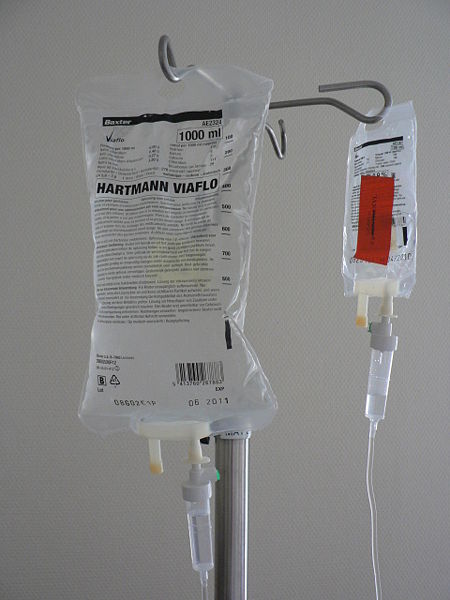what is the dilution when 0.5 ml is diluted to a total of 100 ml
Chapter 11. Solutions
Dilutions and Concentrations
- Learn how to dilute and concentrate solutions.
Often, a worker will demand to change the concentration of a solution by irresolute the amount of solvent. Dilution is the addition of solvent, which decreases the concentration of the solute in the solution. Concentration is the removal of solvent, which increases the concentration of the solute in the solution. (Practise non confuse the 2 uses of the give-and-take concentration here!)
In both dilution and concentration, the amount of solute stays the aforementioned. This gives united states a way to summate what the new solution book must be for the desired concentration of solute. From the definition of molarity, which is:
![]()
we can solve for the number of moles of solute:
![]()
A simpler way of writing this is to use 1000 to represent molarity and V to represent volume. So the equation becomes:
![]()
Because this quantity does not change before and after the alter in concentration, the product MV must be the aforementioned earlier and later on the concentration change. Using numbers to stand for the initial and terminal atmospheric condition, nosotros have:
![]()
as the dilution equation. The volumes must be expressed in the aforementioned units. Note that this equation gives only the initial and last conditions, not the amount of the change. The amount of alter is determined by subtraction.
If 25.0 mL of a two.19 M solution are diluted to 72.8 mL, what is the final concentration?
Solution
It does non matter which fix of weather condition is labelled i or 2, every bit long as the conditions are paired together properly. Using the dilution equation, we take:
![]()
Solving for the second concentration (noting that the millilitre units cancel):
![]()
The concentration of the solution has decreased. In going from 25.0 mL to 72.viii mL, 72.viii − 25.0 = 47.viii mL of solvent must be added.
Test Yourself
A 0.885 Thou solution of KBr whose initial volume is 76.5 mL has more water added until its concentration is 0.500 G. What is the new book of the solution?
Answer
135.4 mL
Concentrating solutions involves removing solvent. Usually this is washed past evaporating or boiling, assuming that the heat of boiling does non bear on the solute. The dilution equation is used in these circumstances besides.
Chemistry Is Everywhere: Preparing Iv Solutions
In a infirmary emergency room, a medico orders an intravenous (IV) delivery of 100 mL of 0.v% KCl for a patient suffering from hypokalemia (low potassium levels). Does an aide run to a supply chiffonier and have out an Iv bag containing this concentration of KCl?
Not likely. It is more probable that the aide must make the proper solution from an Four bag of sterile solution and a more concentrated, sterile solution, called a stock solution, of KCl. The aide is expected to use a syringe to describe upwardly some stock solution and inject it into the waiting Four handbag and dilute it to the proper concentration. Thus the aide must perform a dilution calculation.

If the stock solution is 10.0% KCl and the final volume and concentration need to be 100 mL and 0.l%, respectively, then information technology is an easy calculation to make up one's mind how much stock solution to use:
![]()
Of course, the improver of the stock solution affects the total book of the diluted solution, but the final concentration is probable shut enough even for medical purposes.
Medical and pharmaceutical personnel are constantly dealing with dosages that require concentration measurements and dilutions. It is an important responsibility: calculating the wrong dose tin be useless, harmful, or even fatal!
- Calculate the new concentration or book for a dilution or concentration of a solution.
Questions
- What is the deviation between dilution and concentration?
- What quantity remains abiding when y'all dilute a solution?
- A 1.88 M solution of NaCl has an initial volume of 34.5 mL. What is the terminal concentration of the solution if it is diluted to 134 mL?
- A 0.664 1000 solution of NaCl has an initial volume of two.55 Fifty. What is the last concentration of the solution if information technology is diluted to three.88 L?
- If 1.00 mL of a 2.25 M H2Then4 solution needs to be diluted to 1.00 M, what will exist its final volume?
- If 12.00 L of a 6.00 M HNO3 solution needs to exist diluted to 0.750 M, what volition be its concluding volume?
- If 665 mL of a 0.875 M KBr solution are boiled gently to concentrate the solute to one.45 M, what will be its final book?
- If ane.00 L of an LiOH solution is boiled down to 164 mL and its initial concentration is 0.00555 Yard, what is its last concentration?
- How much water must be added to 75.0 mL of 0.332 G FeCliii(aq) to reduce its concentration to 0.250 K?
- How much h2o must be added to 1.55 L of one.65 Chiliad Sc(NO3)3(aq) to reduce its concentration to 1.00 G?
Answers
- Dilution is a subtract in a solution's concentration, whereas concentration is an increase in a solution'due south concentration.
- 0.484 M
- 2.25 mL
- 401 mL
- 24.6 mL
Media Attributions
- "Infuuszakjes" © 2008 by Harmid is licensed under a Public Domain license
Source: https://opentextbc.ca/introductorychemistry/chapter/dilutions-and-concentrations/
0 Response to "what is the dilution when 0.5 ml is diluted to a total of 100 ml"
Post a Comment